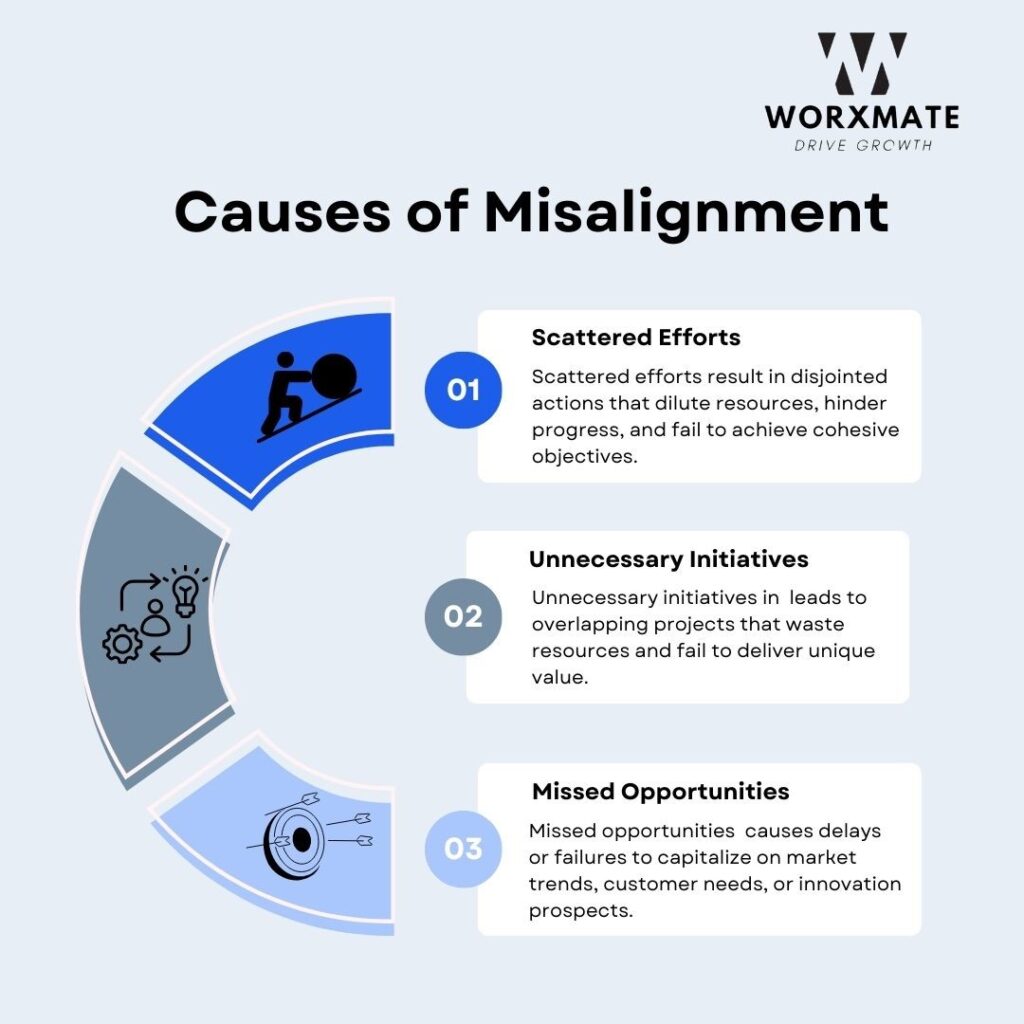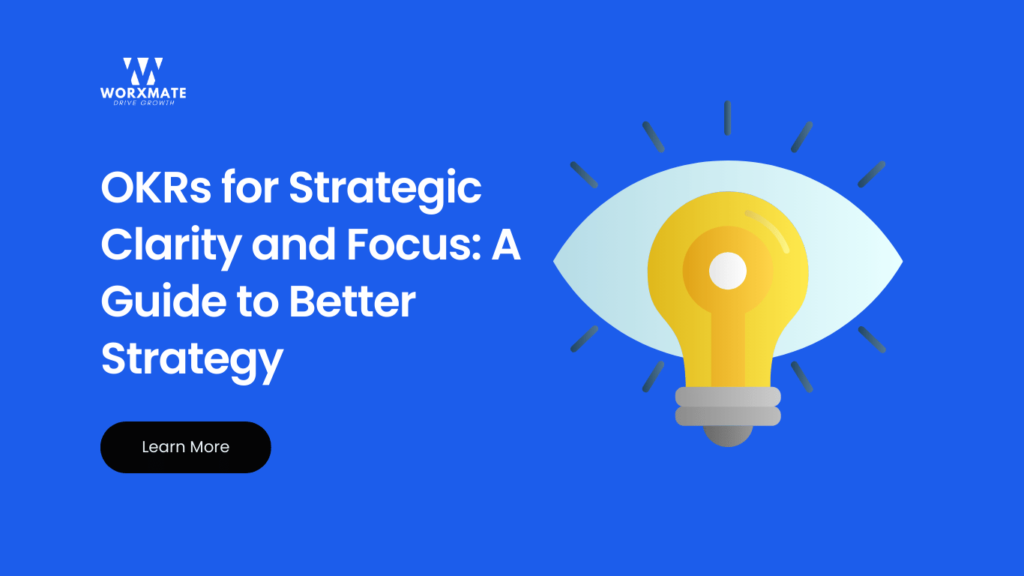The rapidly evolving business landscape poses significant challenges for organizations, especially in the B2B space. Two key challenges stand out: maintaining strategic clarity and ensuring focus across all levels. These challenges are particularly evident in B2B organizations, where the pressure to scale, expand into new markets, and adapt to evolving customer demands often makes alignment and focus a struggle.
Before diving in, let’s lay the groundwork for a deeper understanding.
According to Gallup, only 22% of employees feel that leaders have a clear direction for the organization.
Additionally, Harvard Business Review states that actual strategic alignment among employees, managers, and executives is 2-3 times lower than perceived alignment.
Surprising, right?
Now, the same issue with respect to B2B organizations is that as they scale and expand into new markets or adapt to ever-evolving client demands, ensuring alignment across teams becomes even more critical. Sales, marketing, product, and customer success teams must all be aligned to drive the company’s success. However, achieving this alignment becomes increasingly difficult as the organization grows.

This is due to misalignment, leading to scattered efforts, unnecessary initiatives, and missed opportunities to add value for clients.
Therefore, without a structured framework for linking strategic priorities to team-level execution, employees often struggle to see how their work directly affecting the key business goals.
Also the managers find it challenging to drive performance without clear, measurable targets that connect individual contributions to broader objectives.
Therefore, in B2B, where customer retention, complex sales cycles, and value-driven client relationships are critical, this lack of alignment and clarity can hinder growth, affect client satisfaction, and weaken competitive positioning, requiring a solution like OKRs for Strategic Clarity and Focus.
» OKRs for Strategic Clarity and Focus:
The OKR framework is designed to connect high-level strategic goals with measurable and actionable steps. By establishing clear Objectives paired with specific Key Results, OKRs can help companies align their teams with broader organizational goals, translating big-picture ambitions into tangible outcomes for each department.
This approach fosters cross-functional collaboration, especially in B2B environments where successful outcomes often require coordination across multiple teams. OKRs also drive accountability by providing clear, quantifiable Key Results that track progress and keep everyone focused on what matters.
Additionally, by setting OKRs on a quarterly basis, organizations can promote agility, regularly reassessing their priorities and adjusting as necessary to respond to market changes.
For B2B companies, this structured approach to strategy execution provides the clarity and focus needed to manage complex client relationships, company success streamline operations, and stay ahead of competitors and OKR accompanied by certain key components can help in achieving their goals.
» Practical Tips for Implementing OKRs in B2B:
Start with Company-Level OKRs:
Begin by setting broad OKRs at the company level that align with your strategic goals for the quarter or year. This top-down approach ensures that every team has a clear understanding of the company’s priorities and direction.
Cascade OKRs to Departments and Teams:
Once company-level OKRs are established, encourage each department to set their own OKRs that support these larger goals. In B2B, where departments like sales, product, and customer success often work together on the same client accounts, ensure OKRs are complementary across functions.
Limit Objectives and Focus on Key Results:
To avoid overloading teams, focus on a limited number of Objectives (typically 1-3 per team or department) and ensure each Objective has a few measurable Key Results. This focus allows teams to prioritize efforts effectively.
Regularly Track and Adjust:
Schedule weekly or bi-weekly check-ins to review OKR progress. Encourage transparency and be open to adjusting Key Results if market conditions or client needs change.
Celebrate Achievements and Learn from Challenges:
Acknowledge milestones when Key Results are met and take time to reflect on marketing and sales challenges. These moments of recognition and reflection build motivation and offer valuable insights for future OKR cycles.

We have now realised that strategic clarity is essential for aligning the organization’s goals with individual contributions, ensuring that every employee understands not only the company’s overarching objectives but also how their work directly supports these priorities.
To illustrate this concept, we will understand it better with some examples.
» EXAMPLES:
OKRs for OKR Champions
Objectives: Drive successful adoption and alignment of OKRs across the organization.
Key Results:
- Achieve 100% completion of OKR training sessions for team leads and managers by Q2 2025.
- Conduct monthly OKR alignment check-ins with all department heads
- Ensure 95% of teams set and review OKRs consistently each quarter.
- Resolve 80% of OKR-related challenges within 2 weeks of identification by providing support and resources
OKRs for Management Level
Objectives: Align organizational priorities with departmental and individual objectives to achieve strategic goals.
Key Results:
- Achieve 90% strategic alignment between organizational and departmental OKRs, measured via alignment surveys.
- Hold quarterly strategy and OKR review meetings with all department heads
- Ensure 100% of leadership develops and communicates departmental OKRs
- Establish an OKR dashboard for real-time tracking of progress and alignment across the organization
- Increase management participation in OKR-related feedback and alignment sessions to 100% attendance
These OKRs are designed to help organizations ensure that all teams are focused on strategic goals, fostering alignment and creating a shared sense of purpose and direction.
» Conclusion:
B2B companies looking to boost strategic alignment and operational focus, OKRs offer a robust solution. By setting clear Objectives and measurable Key Results, companies can ensure every team is working toward common goals that support the broader company vision.
OKRs bring structure to strategic planning, drive cross-functional collaboration, and provide a framework for accountability, making it easier to adapt and succeed in a competitive market.
Adopting OKRs might seem like a shift, but with a well-thought-out approach, B2B organizations can build a culture of focus, agility, and continuous improvement—qualities that are critical for long-term growth and success.
If you want to enhance your organization’s strategic alignment and focus, Then Book a call and let Worxmate’s OKR Solution help you in achieving your organization’s goals.



